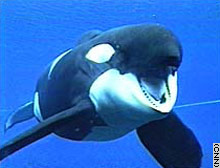
Oops! Wrong title! The orca is neither a killer nor a whale!
18th-century Spanish sailors referred to the orca as ‘whale killer’ (because of their habit of attacking whales), which was incorrectly translated into English as ‘killer whale.’ But like the whale, it also is an aquatic mammal - the largest member of the dolphin family.
Because their behavior is similar to that of wolves, some also call them “sea wolves”. And for those of us who have never seen a live orca, there is the memory of Keiko who starred in all the three Free Willy movies.
The orca has a rubbery but sensitive black skin with a white underbelly, white patches over the eyes and saddle patch markings near the dorsal fin, which provide good camouflage in the flickering, underwater light.
With a weight of up to 10 tons and equipped with sharp, flesh-tearing teeth, the cetacean gathers tremendous momentum as it bears down on prey at speeds of about 55 km/hour.
Orcas hunt sea lions or penguins solo but herd fish together in groups called ‘pods’ and then attack them from different angles.
A pod is not just a group of orcas formed spontaneously but an extended family. Groups of pods sharing the same tradition of sounds by which they communicate (called ‘whale song’) are known as ‘clans’.
Two or more pods come together to form a temporary ‘superpod’ for breeding purposes. After a gestation period of one year and a half, a single calf is born which suckles for about 18 months, staying close to its mother’s side and later retaining a lifelong bond.
There are three types of orca: ‘Resident’ orcas stay within a home range and eat mainly fish; ‘transient’ orcas, as the name suggests, are nomadic in nature, living in the same areas as resident orcas but generally ignoring each other and feeding on whales, fish and marine mammals; ‘offshore’ orcas cruise the open oceans in groups of up to 60, feeding on fish, sharks and turtles.
Orcas socialize by rubbing their bodies together, slapping their tail and pectoral fins against the surface and lifting their heads out of the water, a process called ‘spy-hopping’. This makes them candidates for amusement parks, which hold them in captivity. Fortunately, this fell out of favour with the general public due to the huge success of Free Willy, which inspired a campaign for the release of Keiko.
Keiko was airlifted from the USA to Iceland in July 2002 where he was released into the open sea, but he swam 1400 kms straight to Norway and stayed in a bay there, keeping constant contact with humans till his death in December 2003.
Copyright © 2006 Noël Gama
Friday, November 24, 2006
Orca:The Killer Whale
Subscribe to:
Post Comments (Atom)
No comments:
Post a Comment